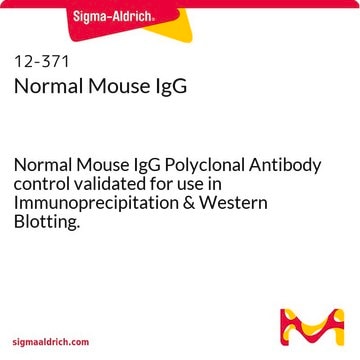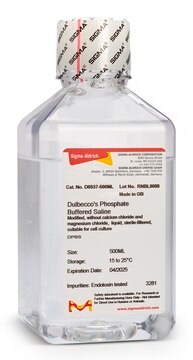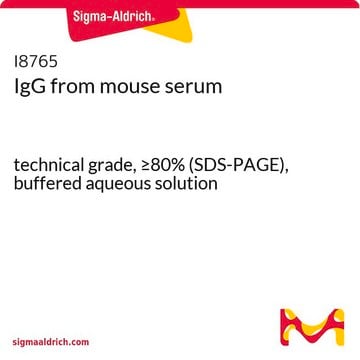11333151001
Roche
Mouse IgG ELISA
Sinonimo/i:
quantification kit for hybridomas | hybridoma quantification | monoclonal quantification
Autenticatiper visualizzare i prezzi riservati alla tua organizzazione & contrattuali
About This Item
Codice UNSPSC:
12352200
Prodotti consigliati
impiego
sufficient for ≤400 tests
Produttore/marchio commerciale
Roche
tecniche
ELISA: suitable
Condizioni di spedizione
wet ice
Temperatura di conservazione
2-8°C
Descrizione generale
An accurate determination of immunoglobulin levels in the hybridoma-culture supernatant is essential to study the effect of drugs or physical parameters on hybridoma growth, or the level of immunoglobulin secretion.
Assay time: Approximately 2.5 - 4.5 hours
Sample material: Hybridoma supernatant, ascites, mouse sera, and purified IgG preparations (the assay is not applicable for the quantification of IgG preparations purified with strongly denaturing buffers, for example, during the elution from affinity chromatrography matrices)
Sensitivity: Approximately 10 ng IgG/ml
Assay time: Approximately 2.5 - 4.5 hours
Sample material: Hybridoma supernatant, ascites, mouse sera, and purified IgG preparations (the assay is not applicable for the quantification of IgG preparations purified with strongly denaturing buffers, for example, during the elution from affinity chromatrography matrices)
Sensitivity: Approximately 10 ng IgG/ml
Enzyme immunoassay for the determination of mouse IgG in mouse hybridoma supernatant and ascites.
Immunoglobulin G (IgG) belongs to the immunoglobulin family and is a widely expressed serum antibody. Each immunoglobulin has two heavy chains and two light chains connected by a disulfide bond. It mainly helps in immune defense. It is a glycoprotein. Mouse IgG is further divided into five classes- IgG1, IgG2a, IgG2b and IgG3.
Specificità
The mouse IgG ELISA shows no cross-reactivity with other Ig classes from mouse or bovine IgG (<0.1%).
Applicazioni
The kit can be used for the determination of mouse IgG in hybridoma supernatants, ascites, mouse sera, etc.
Azioni biochim/fisiol
Immunoglobulin G (IgG) participates in hypersensitivity type II and type III reactions. IgG2a has cytotropic properties and IgG2 molecules have the ability to activate the complement system. IgG helps in opsonization, complement fixation and antibody dependent cell mediated cytotoxicity.
Caratteristiche e vantaggi
- Reliable: Highly specific antibodies supplied with the kit
- Easy: Follows a standard ELISA protocol
- Fast: Results in 2 - 4 hours
- Sensitive: Detects down to 10 ng/ml
- Highly specific: No crossreactivity with FBS
Confezionamento
1 kit containing 9 components.
Principio
The Mouse IgG ELISA follows a standard sandwich ELISA protocol. First, a special capture antibody is bound to the wells of the microplate. The antibody used is an optimized mixture of immunosorptively purified, polyclonal anti-mouse IgG from sheep, which possesses equivalent affinity to all IgG subclasses (including IgG3). After blocking with post-coating buffer, the mouse IgG, contained in the sample to be assayed (e.g., hybridoma supernatant, ascites dilution), is bound to the capture antibody. Next, a balanced mixture of anti-mouse-λ- and anti-mouse-κ-antibodies (immunosorptively purified Fab fragments), conjugated to POD, is added and bound to the mouse IgG. In the next step, the POD substrate ABTS is added and metabolized to form a colored reaction product. The absorbance of the sample is determined with a microplate (ELISA) reader, then compared with the absorbance values of a reference curve. A standard solution to produce a calibration curve is provided with the kit.
Nota sulla preparazione
Working solution: Preparation of Standard Solution
After complete reconstitution, pipette 10 aliquots (50 μl each) into the remaining 10 empty vials, close tightly.
Storage conditions (working solution): Standard Solution
Stable for several months when stored in aliquots at -15 to -25 °C; avoid more than three freeze/thaw cycles.
- Open standard carefully to avoid loss of lyophilizate material. Add exactly 500 μl double-distilled water. Note: On the label of vial 5, the contents of IgG per vial are provided in mg/fl (flask). Since the contents of the vial are dissolved in 0.5 ml, the IgG concentration (in mg/ml) will be exactly twice the value printed on the label after reconstitution.
- Close the bottle carefully. Allow to the bottle to equilibrate at 15 to 25 °C for 30 minutes. Then dissolve the contents of the bottle completely by gentle swirling. Note: Avoid the formation of foam, and do not shake.
After complete reconstitution, pipette 10 aliquots (50 μl each) into the remaining 10 empty vials, close tightly.
Storage conditions (working solution): Standard Solution
Stable for several months when stored in aliquots at -15 to -25 °C; avoid more than three freeze/thaw cycles.
Altre note
For life science research only. Not for use in diagnostic procedures.
Solo come componenti del kit
N° Catalogo
Descrizione
- Coating Antibody, anti-mouse-IgG
- Coating Buffer Concentrate
- Detergent
- Blocking Reagent
- Standard
- Conjugate, optimized mixture of anti-mouse-k-POD antibody and anti-mouse-l-POD antibody
- Substrate Buffer
- ABTS Substrate Tablets
- 20 empty vials, for the preparation of the standard dilutions
Vedi tutto (9)
Avvertenze
Danger
Indicazioni di pericolo
Consigli di prudenza
Classi di pericolo
Aquatic Chronic 3 - Eye Dam. 1 - Skin Sens. 1
Codice della classe di stoccaggio
11 - Combustible Solids
Classe di pericolosità dell'acqua (WGK)
WGK 2
Punto d’infiammabilità (°F)
230.0 °F
Punto d’infiammabilità (°C)
110 °C
Scegli una delle versioni più recenti:
Possiedi già questo prodotto?
I documenti relativi ai prodotti acquistati recentemente sono disponibili nell’Archivio dei documenti.
I clienti hanno visto anche
The Laboratory Rat (1998)
Molecular Genetics of Immunoglobulin, 17 (1987)
The Immunoglobulins: Structure and Function (1998)
Micha Drukker et al.
Methods in molecular biology (Clifton, N.J.), 407, 63-81 (2008-05-06)
Differentiated cell types derived from human embryonic stem cells (hESCs) may serve in the future to treat various human diseases and to model early human embryonic development in vitro. Fulfilling this potential, however, requires extensive development of methods and reagents
Antibody structure, instability, and formulation.
Wang W
Journal of Pharmaceutical Sciences, 96(1), 1-26 (2007)
Il team dei nostri ricercatori vanta grande esperienza in tutte le aree della ricerca quali Life Science, scienza dei materiali, sintesi chimica, cromatografia, discipline analitiche, ecc..
Contatta l'Assistenza Tecnica.
















